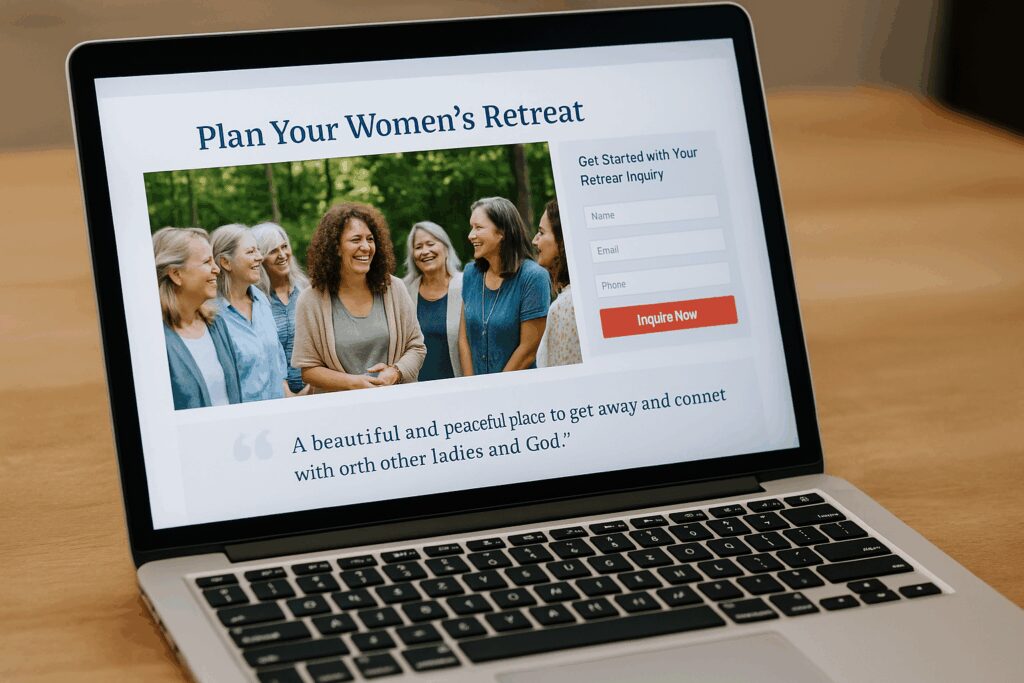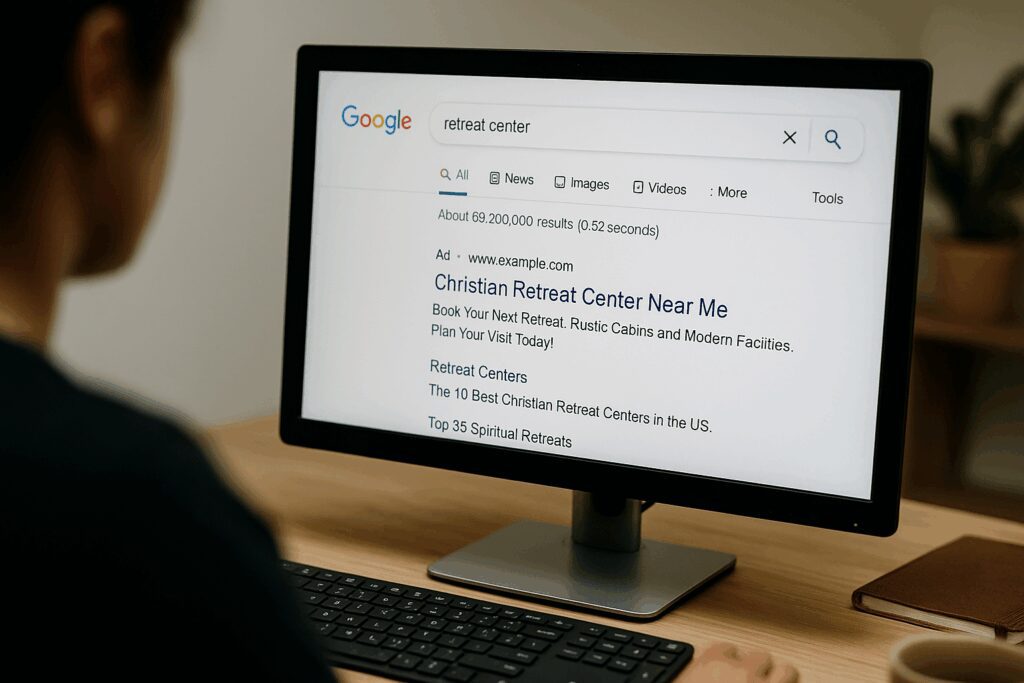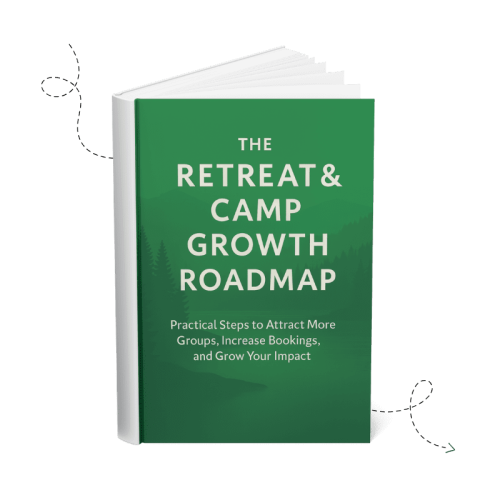Retreat & Camp Growth Roadmap Step 4: Capture High-Intent Leads
Introduction
When retreat centers and camps want to grow beyond referrals and repeat groups, the key is learning how to capture high-intent leads—those who are actively searching for a place to host their retreat or camp program. These are the moments of decision, when leaders are ready to take action. Step 4 in the Retreat & Camp Growth Roadmap helps you maximize these opportunities by combining three powerful strategies: tailored landing pages, search campaigns, and retargeting ads.
Why This Step Matters
High-intent leads are not casual browsers—they are group leaders, parents, or planners already motivated to book. They are often actively comparing options and preparing to make a decision. Meeting them at this point of decision means your retreat or camp can show up right when it matters most. For leaders committed to stewardship and impact, capturing high-intent leads ensures your resources are focused on those most ready to take action:
- Ensures your ministry or camp is visible at the right time.
- Increases the likelihood of inquiries and bookings compared to broader awareness efforts.
- Maximizes stewardship by focusing resources where they deliver the greatest return.
- Advances your mission by connecting with aligned groups at the exact moment they’re looking for you.
Is This a Focus Area You Need to Work On Now?
Ask yourself:
- Do you have dedicated landing pages for your key group types (youth, women, families, schools)?
- Are you showing up in Google searches when planners look for retreat venues in your area?
- Do you run paid search campaigns to reach people at the top of search results?
- Do you have retargeting ads to remind visitors who didn’t inquire the first time?
- Are you tracking results in terms of inquiries and bookings—not just clicks or visits?
If you answered “no” to any of these, this step can help you convert intent into inquiries and grow your impact.
Putting This Step into Practice
Focus Area #1: Create Landing Pages
Goal: Provide tailored content and clear next steps for each group type you serve.
Generic website pages speak to everyone—and in doing so, often connect with no one in particular. Dedicated landing pages allow you to:
- Align messaging with specific audience needs (e.g., youth pastors, women’s ministry leaders).
- Increase conversions with focused calls-to-action and simple inquiry forms.
- Improve visibility in search results with keyword-optimized content.
- Support ad campaigns by giving each audience a page designed just for them.
Best practices include using strong headlines, authentic visuals, trust-building testimonials, and clear inquiry forms. Even a modest increase in conversion rate can significantly multiply inquiries without increasing traffic.
📖 Read: Build to Convert: How to Create High-Performing Landing Pages for Retreat & Camp Websites
📥 Download the Landing Page Planning Worksheet

Focus Area #2: Activate Search Campaigns
Goal: Reach planners the moment they search for a venue.
Search ads allow you to appear at the top of Google results when someone types “retreat center near me” or “youth retreat venue in [state].” Unlike SEO (which takes time), paid search ads provide immediate visibility. When run well, search campaigns:
- Help fill off-season or midweek calendar gaps.
- Introduce your center to new group types outside your current network.
- Provide measurable data on demand and booking drivers.
Best practices include defining target audiences, aligning ads with relevant landing pages, setting budgets with stewardship in mind, and tracking success by inquiries and bookings. Nonprofit retreat centers can also leverage the Google Ad Grant, which offers up to $10,000 per month in free search advertising for qualified organizations.
📖 Read: How Retreat Centers & Camps Can Activate Search Campaigns to Attract More Groups
📥 Download the Search Campaign Planning Worksheet

Focus Area #3: Run Retargeting Ads
Goal: Stay top-of-mind with website visitors who don’t convert right away.
Most planners and parents don’t inquire on their first visit—they compare, research, and take time to decide. Retargeting ads allow you to:
- Re-engage visitors across platforms like Google Display, YouTube, Facebook/Instagram, and LinkedIn.
- Stay visible during real-world decision cycles (30–90 days for retreats, 7–30 days for camps).
- Build trust with gentle reminders, compelling visuals, and invitational messaging.
Best practices include defining your retargeting audiences, refreshing creative regularly, limiting ad frequency, and measuring inquiries and bookings generated by retargeting campaigns.
📖 Read: How Retreat Centers & Camps Can Use Retargeting Ads to Stay Top-of-Mind and Win More Bookings
📥 Download the Retargeting Ad Campaign Planning Worksheet

Pulling It All Together
Landing pages, search campaigns, and retargeting ads work best as a system. Search ads drive immediate visibility, landing pages convert interest into inquiries, and retargeting ads keep you top-of-mind with those still deciding. Together, they create a powerful pathway for capturing high-intent leads.
Immediate action steps:
- Develop one landing page tailored to a priority audience segment, such as youth retreats or women’s ministry retreats.
- Launch a small search campaign targeting 3–5 high-intent keywords.
- Set up a retargeting campaign to re-engage visitors who left without inquiring.
- Track conversions with analytics and connect results directly to bookings.
Mini Case Study
Refreshing Mountain Retreat Center is a strong example of this step in action. They were getting most of their retreat inquiries from past customers, word-of-mouth referrals, and some organic search traffic. We helped them build and publish landing pages for specific group types they wanted to target, including youth groups, women’s groups, men’s groups, and school groups. We also set up and launched paid search campaigns targeting relevant keywords and sending that traffic to those landing pages. Finally, we implemented retargeting ads to re-engage prior website visitors who hadn’t yet inquired. All of this added up to a significant year-over-year increase in retreat inquiries. For more details and results, see the full case study here: Refreshing Mountain Retreat Center Case Study.
Practical Takeaways
Before diving into the specific steps, it’s helpful to step back and summarize what this stage means for retreat centers and camps. Capturing high-intent leads is not about chasing every possible visitor—it’s about stewarding your time and resources wisely to connect with the right people at the right time.
- Dedicated landing pages speak directly to each audience and boost conversions.
- Paid search campaigns help fill calendar gaps by reaching planners at the right time.
- Retargeting ads ensure you don’t lose touch with interested visitors.
- Stewardship matters: start small, measure results, and scale wisely.
- Combining all three strategies creates a reliable, repeatable path for capturing more inquiries.
- Partnering with experienced retreat marketing agencies can save time and improve outcomes.
Together, these strategies form a balanced system that connects awareness to action. By focusing on the most ready-to-book audiences, you can increase inquiries, serve more groups, and advance your mission. Next, let’s look at how you can begin applying this step in your own retreat or camp marketing plan.
Ready to Take the Next Step?
Capturing high-intent leads ensures your retreat center or camp is present when it matters most—at the moment of decision. By combining landing pages, search campaigns, and retargeting ads, you can consistently turn interest into inquiries and grow your impact.
If you found this helpful, here are four great next steps to continue your journey:
🧭 Move to the Next Step: Develop Organic Traffic
Learn how to attract new groups by optimizing your site content and improving visibility in search engines.
[Read Develop Organic Traffic Article]
📘 Download the Retreat & Camp Growth Roadmap eBook
Get the full 3-stage system we use to help retreat centers and camps grow with clarity and purpose.
[Download the eBook]
🌱 Learn More About How We Help Retreat Centers & Camps
We’re a Christian-owned digital marketing agency that helps retreat centers and camps grow attendance, bookings, and impact through practical strategies rooted in clarity and stewardship.
[See How We Can Help]
🤝 Schedule a Free Discovery Call
Want help applying this to your unique situation? Let’s talk. We’ll explore where you are now, where you want to go, and how to take the next faithful step.
[Book a Discovery Call]
You don’t have to figure this out alone. Let’s build something meaningful—together.
Frequently Asked Questions
1. What is a high-intent lead?
A high-intent lead is someone actively searching for a retreat or camp venue and ready to make a decision. Unlike casual browsers, these visitors are closer to booking and more likely to convert.
2. Why do I need separate landing pages?
Generic pages don’t speak to specific audiences. A youth pastor, women’s ministry leader, and school administrator each have different needs. Landing pages tailored to each audience boost conversions and improve search visibility.
3. How much should I budget for Google Ads?
Budgets vary, but even $500–$1,000 per month can generate meaningful inquiries. Compare ad spend to the value of one booking. If one group generates $8,000 in revenue, a modest budget can pay for itself with just one new booking.
4. What is the Google Ad Grant?
The Google for Nonprofits Ad Grant offers eligible nonprofit organizations up to $10,000 per month in free Google Search ads. It’s a valuable tool for retreat centers to expand visibility without straining budgets.
5. Do retargeting ads annoy potential guests?
Not when done well. Setting frequency limits and refreshing creative ensures your ads feel like friendly reminders instead of pushy sales pitches.
6. Which platforms work best for retargeting?
Google Display and YouTube keep you visible across the web, while Facebook and Instagram are effective for parents and group leaders. LinkedIn can be a strong channel for leadership retreats.
7. How soon will I see results from these strategies?
Search campaigns and retargeting ads can deliver inquiries within weeks. Landing pages improve over time, especially as they gain visibility in search results.
8. How do I measure success?
The most important metrics are inquiries and bookings. Track cost per inquiry, conversion rates, and ROI—not just clicks or impressions.
9. What if my team doesn’t have the time or expertise to manage campaigns?
You can start small in-house, but many retreat centers choose to partner with camp marketing agencies to save time and maximize results. Look for an agency experienced in christian camp marketing.
10. How do these strategies fit into the bigger growth roadmap?
Capturing high-intent leads is Step 4. Once you have this system working, Step 5: Develop Organic Traffic helps you grow long-term visibility through SEO and content marketing.





